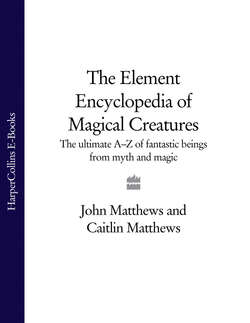Читать книгу The Element Encyclopedia of Magical Creatures: The Ultimate A–Z of Fantastic Beings from Myth and Magic - John Matthews - Страница 152
ASS
ОглавлениеThe most frequently described symbolism for the ass, or its lowlier brother the donkey, focuses on its stupidity, stubbornness, inferiority and fertility, as well as its lasciviousness. An ass in a lion’s skin is said to suggest a blustering coward, or a fool pretending to be wise. The earliest depictions of the ass come from Egyptian and Syrian monuments, and these represent not the humble donkey, but the wild ass – the onagar – a much larger animal which is more ancient than the horses described in Semitic traditions. This beast was used like a horse to draw the heavy chariots of the Sumerians and as a baggage animal for their armies. As a desert animal, the ass was associated with the Egyptian god of evil, Set, to whom it was sacrificed, and in later Egyptian symbolism Set himself was sometimes personified as a donkey.
For the classical Greeks, the ass represented sloth and infatuation; it was sacred to Dionysus and Priapus and the god Typhon was sometimes depicted with the head of an ass. It was also sacred to Cronos, and Silenus, the god of wine, is sometimes shown riding an ass. During the Roman holiday of Vestalia, donkeys were garlanded and given sweet honey cakes to eat. In China, the Taoist immortal Chang Kuo-lao, a bringer of fertility to childless mothers, rides on a magical donkey which, when not required, becomes a drawing of a donkey on a sheet of paper, and can be folded up and put away. In Hindu mythology, asses drew the chariot of the underworld god Ravana when he abducted the beautiful maiden Sita, and is thus seen as an inauspicious animal by the Hindus. For Buddhists, the ass is a symbol of simplicity and asceticism and is portrayed as sleeping by the roadside on a bed of leaves.
Plutarch, the Roman writer, says the ass was revered by the Jews, because it found springs in the desert during the flight from Egypt. The biblical wild ass was symbolic of wildness and desolation. People of wealth drank asses’ milk and, like Cleopatra, occasionally bathed in it. Early Christians were accused by their opponents of worshipping the ass, and the Roman writer Tertulian mentioned the existence of caricatures of ‘the ass-hoofed god of the Christians’, which was also believed to have ass’s ears. The 1st-century Gnostics believed that the Lord Sabbaoth, a being of great evil, had an ass’s head.
During the medieval era, on 14 January every year, the Festival of Fools was celebrated, and the Feast of the Ass was an important part of this. Sacred individuals and royalty were caricatured at this event with impunity, and the biblical stories of Baalam’s Ass and the Flight into Egypt were burlesqued. More seriously, in Christian tradition, the ass or donkey symbolized Christ’s entry into Jerusalem. In later Christianity, however, it came to represent the devil, as it brayed in the night and was said to bring bad luck. This notion was shared by the followers of Islam, who held the ass to be an accursed creature that desired to bring misfortune to its owner and brayed to call up evil things.
In the ancient Persian religion of Zoroastrianism, the three-legged ass is often equated with the Unicorn because it has a single horn of gold growing from its forehead. In the Bundahish, a 9th-century commentary on the works of Zoroaster, the three-legged ass is described as pure white with eyes in the usual place and a further two in both the forehead and the crown of its head. It has three mouths, each the size of a house, a further three in its forehead and three more on its body. It is thus able to know whatever evil is being plotted or any attempt that might be made to harm it. The creature is so vast that the hooves of its three legs as it stands in the ocean cover an area large enough for a thousand sheep, while a similar number of horsemen could hide beneath a single spur of its hoof. It is considered to be a symbol of righteousness, a servant of the divine Lord Ahuramazda in the fight against evil. It purifies the putrid oceans with its urine, and the amber that washes up on the shore is believed to be its dung. Its white body is considered a symbol of purity and it is known as a champion of the oppressed.
In Welsh tradition, a king named March had been cursed with ass’s ears, which he kept hidden beneath a hood. But in the end he could not contain the secret any longer, and whispered it into a bed of reeds. Later, a poor musician made a flute out of one of these reeds, and found that when he blew it, instead of music it would only repeat over and over, ‘King March has ass’s ears.’ The musician was able to make use of this information when the king imprisoned him – in return for freedom and a purse of gold, he promised to destroy the flute. But, before this could happen, a gust of wind blew through the flute causing it to play on its own so that the secret was out.
The great sacred novel of the classical world, The Golden Ass by Lucius Apuleus, tells the story of a man turned into an ass for mocking the gods. His subsequent adventures teach him a great deal about the sacred mysteries and, in the end, he receives a vision of the goddess Isis who restores him to human form.
